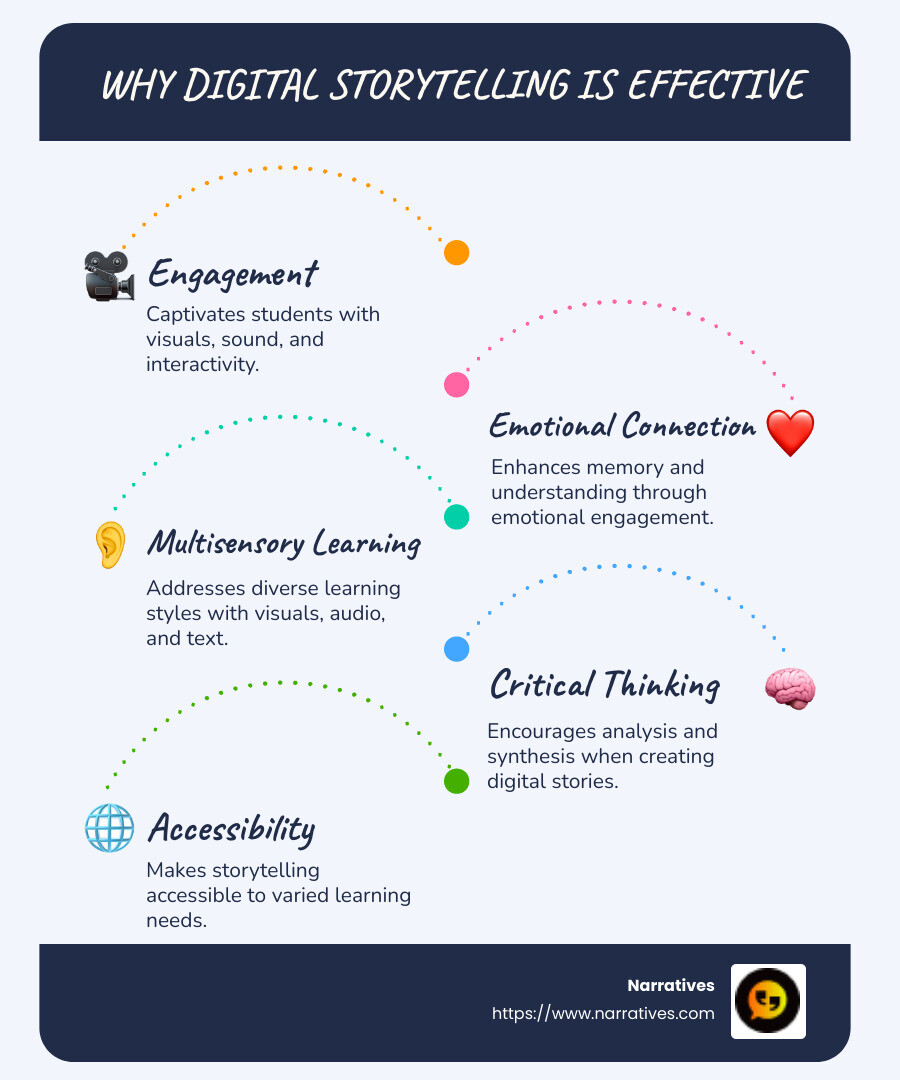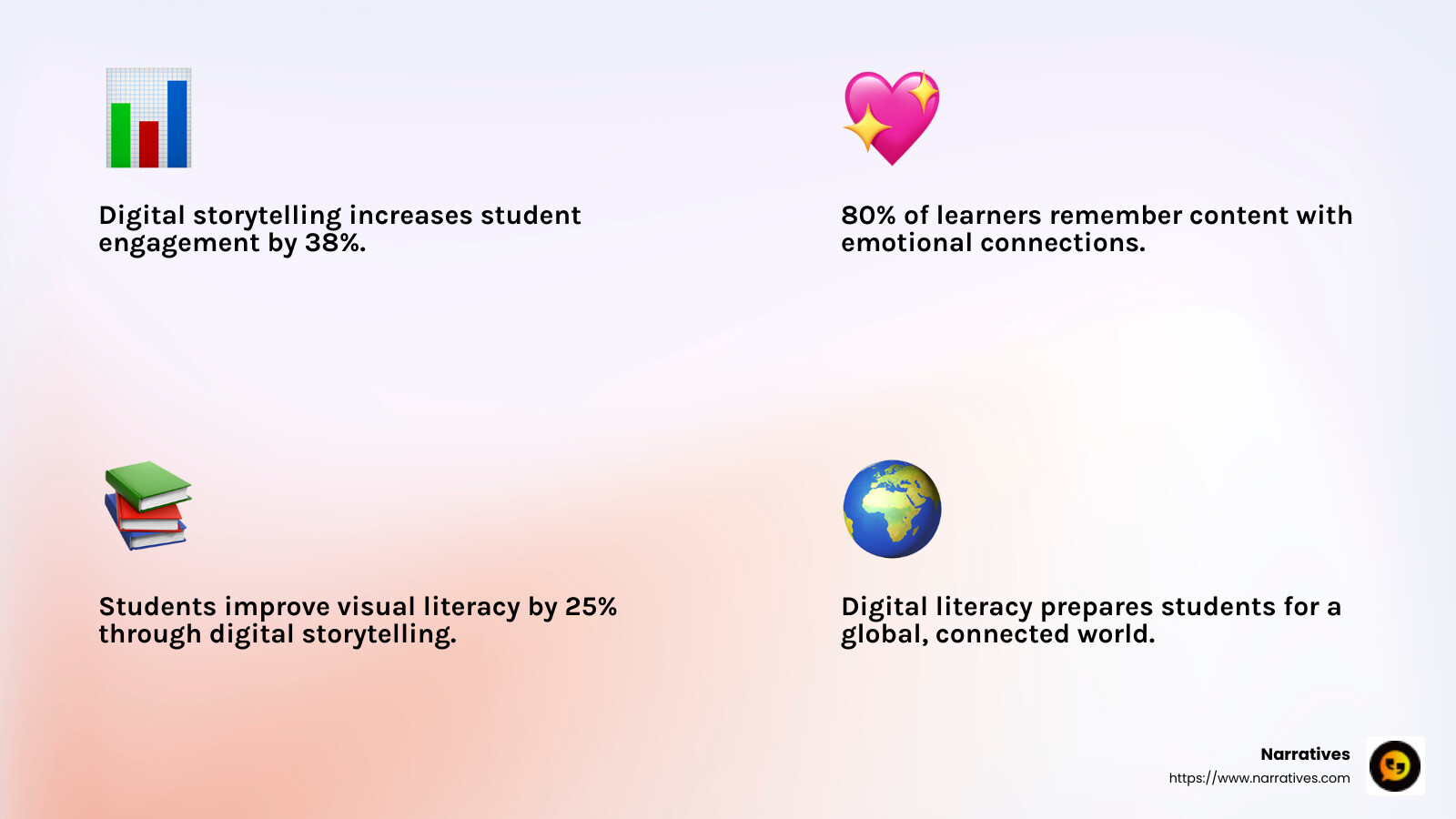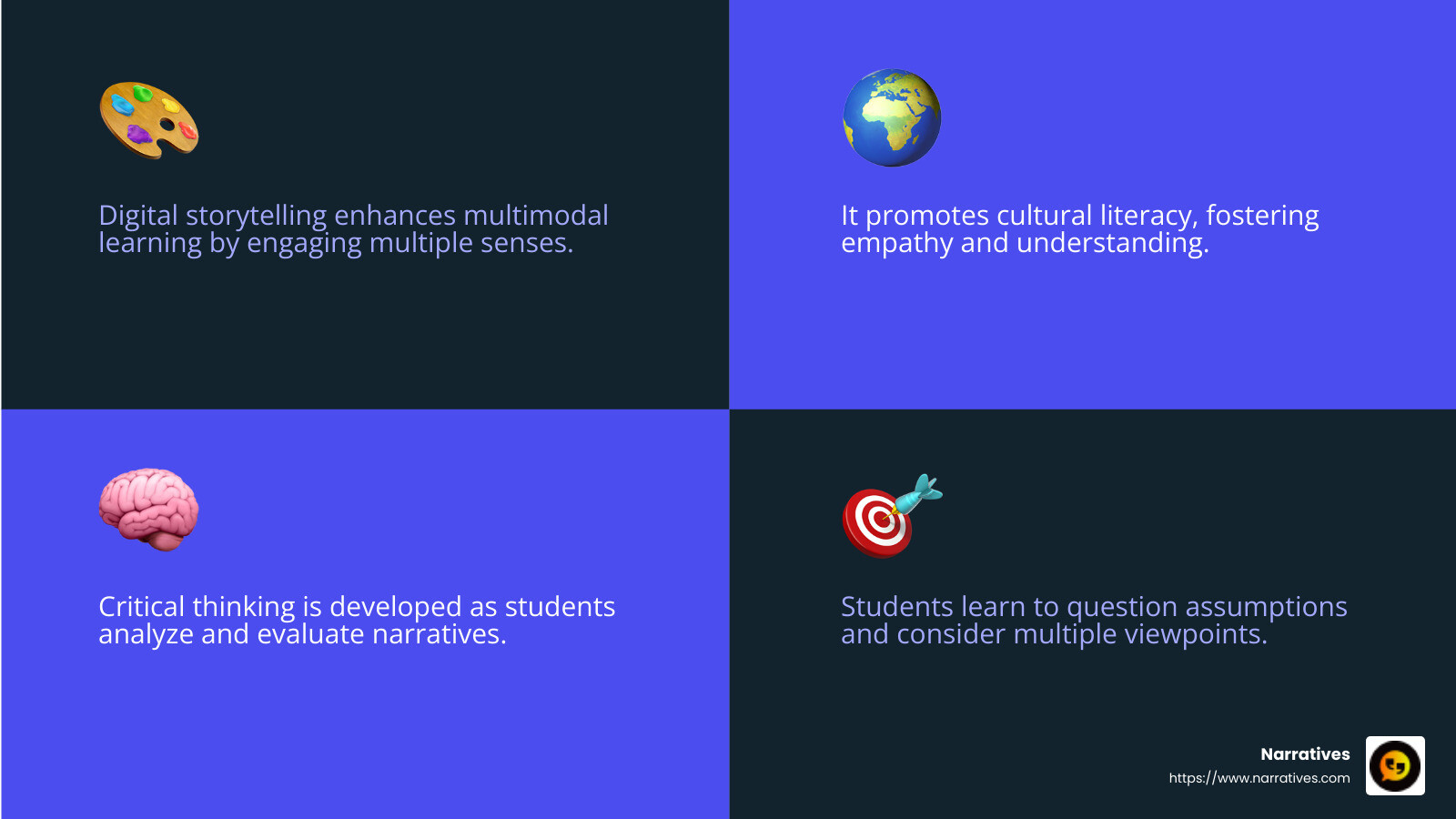Once Upon a Lesson: The Effectiveness of Digital Storytelling in Education

Why is digital storytelling an effective learning tool?
Digital storytelling uniquely combines the tradition of storytelling with modern technology, creating an engaging and powerful educational experience. Here’s why it stands out:
- Engagement: Digital storytelling captivates students with visuals, sound, and interactivity.
- Emotional Connection: Stories tap into emotions, enhancing memory and understanding.
- Multisensory Learning: Incorporates visuals, audio, and text, addressing diverse learning styles.
- Critical Thinking: Students analyze and synthesize information when creating digital stories.
- Accessibility: Technology makes storytelling accessible to varied learning needs.
Education has always relied on storytelling as a bridge to understanding complex ideas. With the advent of digital storytelling, this bridge is transformed into an immersive pathway filled with memorable learning experiences. By integrating visuals, music, and interactivity, digital storytelling draws students into a lesson, making learning both interactive and impactful.
Students don't just hear about rain; they experience its soft patter and emotional resonance. Imagine a tool that not only tells a story but allows students to influence its outcome, boosting their engagement and critical thinking. This is the magic of digital storytelling—a blend that sparks curiosity and fosters a deep connection with the material.
Digital storytelling is not just about narrating a story; it's about creating meaningful educational journeys.

Why is digital storytelling an effective learning tool terms at a glance:
- digital storytelling for students
- digital storytelling guide for educators
- interactive digital storytelling examples
Why is Digital Storytelling an Effective Learning Tool?
Engagement is at the heart of why digital storytelling is so effective. Unlike traditional methods, digital storytelling uses visuals, sound, and sometimes even interactivity to capture students' attention. Imagine walking through a digital forest where each tree is a piece of information waiting to be finded. This element of exploration keeps students intrigued and eager to learn more.
But it's not just about keeping students interested. Emotional connection plays a crucial role too. Stories have the power to evoke emotions, making them memorable and impactful. Think of Daniel in the lion’s den—a story many remember from childhood because it resonates emotionally, teaching lessons of faith and courage. When students feel something, they remember it longer.
Digital storytelling also redefines literacy. It's not just about reading and writing anymore. Literacy means understanding and creating content across multiple platforms. By engaging with digital stories, students develop skills in visual literacy, audio comprehension, and even cultural understanding. This broader definition of literacy prepares students for a connected, digital-first world.

Incorporating digital storytelling in education isn't just about using new technology. It's about enhancing the learning experience by making it more engaging, emotionally resonant, and relevant to the skills students need today.
Benefits of Digital Storytelling in Education
Digital storytelling offers a range of benefits that make it a powerful tool in education. Let's explore some key areas where it excels: multimodal learning, cultural literacy, and critical thinking.
Multimodal Learning
Digital storytelling engages multiple senses, creating a rich learning environment. Unlike traditional methods that rely heavily on text, digital stories use a mix of visuals, audio, and sometimes interactive elements. This approach caters to different learning styles, whether students are visual, auditory, or kinesthetic learners.
For example, a digital story about the water cycle might include animations of rainfall, sound effects of thunder, and interactive quizzes. This combination helps students understand complex concepts more deeply and retain information longer.
Cultural Literacy
Digital storytelling is a bridge to cultural literacy. By exposing students to diverse narratives, it fosters empathy and understanding. Stories from different cultures help students appreciate diverse perspectives and experiences.
Consider a classroom project where students create digital stories about their cultural backgrounds. This not only improves their technical skills but also promotes inclusion and empathy among peers. Hearing stories from classmates can transform abstract cultural concepts into relatable, human experiences.
Critical Thinking
Creating digital stories requires students to engage in critical thinking. They must analyze information, evaluate sources, and synthesize ideas into a coherent narrative. This process involves making decisions about what content to include, how to present it, and which digital tools to use.

Through this creative process, students learn to question assumptions and consider multiple viewpoints. They also develop problem-solving skills as they steer technical challenges, such as editing videos or creating graphics.
In summary, digital storytelling enriches education by supporting multimodal learning, enhancing cultural literacy, and fostering critical thinking. It prepares students for a world where these skills are increasingly valuable.
Next, we'll explore how digital storytelling supports student learning through authenticity, motivation, and creativity.
How Digital Storytelling Supports Student Learning
Digital storytelling is more than just a fun classroom activity. It's a tool that supports student learning in profound ways. Let's look at how it fosters authenticity, motivation, and creativity.
Authenticity
Digital storytelling brings real-world relevance to classroom projects. When students create digital stories, they often tackle real issues or share personal experiences. This authenticity makes learning more meaningful.
For instance, students might work on a digital project about environmental conservation, creating a video that encourages community action. Knowing their work could make a difference motivates them to engage deeply with the subject matter.
This approach also helps address the issue of "cheatable" assessments. When students are invested in authentic projects, they're less likely to resort to shortcuts. Instead, they focus on producing genuine, impactful work.
Motivation
Digital storytelling taps into intrinsic motivation by giving students a voice. They're not just completing assignments for a grade; they're sharing stories that matter to them. This shift in perspective can transform their attitude toward learning.
Imagine a student who is passionate about local history. By creating a digital story about a historical event in their community, they become more engaged and invested in the learning process. This personal connection to the content fuels their motivation to excel.
Moreover, knowing their work will be shared publicly or used by others adds an extra layer of motivation. Students strive for high-quality work when they know it will have an audience beyond the classroom walls.
Creativity
Creativity flourishes in digital storytelling. Students have the freedom to experiment with different formats, such as videos, podcasts, or digital books. This flexibility allows them to express their ideas in unique and innovative ways.
Creating a digital story involves combining visuals, audio, and text to convey a message. This process encourages students to think outside the box and explore new ways of communicating. They learn to use digital tools creatively, developing skills that are valuable in today's tech-driven world.
In a digital storytelling project, a student might choose to animate a historical event, adding sound effects and voiceovers to bring the story to life. This creative process not only improves their technical skills but also deepens their understanding of the content.
In summary, digital storytelling supports student learning by fostering authenticity, motivation, and creativity. These elements transform the educational experience, making learning more engaging and impactful.
Next, we'll explore the digital storytelling tools available for teachers to improve their classroom projects.
Digital Storytelling Tools for Teachers
Digital storytelling is a powerful way to engage students, and using the right tools can make all the difference. Let's explore some key tools—video, audio, and graphics—that can help teachers create compelling digital stories.
Video
Video is a dynamic way to tell stories. It combines visuals, sound, and motion, making it a highly engaging medium. According to research, teachers often use simple tools like PowerPoint to create video presentations, adding music and sound effects to improve storytelling.
Teachers can use video to showcase student projects, explain complex concepts, or bring historical events to life. For example, a video about the parable of the sower can illustrate different learning outcomes, just like the story illustrates the impact of the gospel on various people.
Audio
Audio elements can add depth and emotion to digital stories. They can include music, sound effects, or voiceovers. Audio storytelling can be particularly effective for podcasts or when resources are limited.
Using audio, students can create podcasts that explore topics like local history or personal experiences. This not only helps improve their communication skills but also builds empathy by sharing diverse perspectives.
Graphics
Graphics are essential for visual storytelling. They can simplify complex information and make stories more engaging. Teachers can use graphics to create infographics, digital posters, or storyboards.
Programs like Canva or Adobe Spark offer user-friendly platforms to create stunning graphics. These tools enable students to visualize data, illustrate narratives, and make their projects visually appealing.
By integrating these tools, teachers can improve their digital storytelling projects, making them more engaging and effective for student learning. Next, we'll address some frequently asked questions about digital storytelling.
Frequently Asked Questions about Digital Storytelling
What is Digital Storytelling?
Digital storytelling is the art of using digital elements—like video, audio, graphics, and text—to tell a story. It's a method that combines traditional storytelling with digital technology to create engaging narratives. In education, digital storytelling is used to present course content or assess student learning. It transforms lessons into interactive experiences that captivate students’ attention and make learning more memorable.
How does Digital Storytelling differ from traditional storytelling?
Traditional storytelling relies on oral or written narratives, often shared through books or spoken word. Digital storytelling, on the other hand, uses technology to enhance the story. It can include videos, podcasts, or interactive infographics. This digital approach not only engages multiple senses but also allows for a more immersive experience. For instance, a story about ancient Greece can be brought to life with visuals and sound effects, making it more vivid and relatable for students.
What are some examples of Digital Storytelling in education?
Video Projects: Students can create video presentations on topics like science experiments or historical events. This helps them learn by doing and makes the subject matter more tangible. For example, a video illustrating the water cycle can include animations and voiceover to explain each step.
Podcasts: Audio storytelling can be used for subjects like literature or social studies. Students might create podcasts discussing a book they've read or interviewing a local historian about their community's past.
Infographics: Teachers and students can use graphics to simplify complex data or processes. An infographic on the life cycle of a butterfly, for example, can visually represent each stage, making it easier for students to understand and remember.
These examples show how digital storytelling can make learning more interactive and engaging, helping students connect with the material on a deeper level.
Next, we'll dig into the conclusion, exploring how Narratives, through partnerships and social impact, plays a role in the digital storytelling landscape.
Conclusion
As we wrap up our exploration of why digital storytelling is an effective learning tool, it's clear that this innovative approach has the power to transform education. But it's not just about engaging students—it's also about the broader impact on communities and society.
Narratives is at the forefront of this change. By partnering with non-profits and purpose-driven organizations, we help lift underrepresented voices through high-quality, emotionally resonant content. Our work goes beyond storytelling; it's about creating a meaningful social impact.
Non-Profit Partnerships
Our partnerships with non-profits focus on sharing stories that matter. These collaborations allow organizations to highlight their missions and the communities they serve. By crafting compelling narratives, we help these groups inspire action and build trust with their audiences.
For example, Pars Equality Center uses storytelling to empower Persian-speaking immigrants. Through our partnership, we help them share impactful initiatives, from legal assistance to cultural integration, showcasing their vital work in supporting Iranian and Afghan immigrants.
Social Impact
Digital storytelling has the potential to drive social change. By amplifying the voices of those often unheard, we foster empathy and understanding. In turn, this can lead to positive action and community building. Our focus on social impact aligns with our mission to humanize the news and create content that resonates on a deeper level.
In conclusion, digital storytelling is more than just a tool for education—it's a catalyst for change. Through our work at Narratives, we're committed to leveraging the power of stories to make a difference in the world.
For more on how we can help your organization share its story, visit Narratives. Let's create impactful stories together.


